Local Citation Network and Citation Gecko: making literature discovery fun
Literature review can be tedious and often involves manually checking a paper's references. Two recent web apps, Local Citation Network and Citation Gecko, aid this process by constructing and visualizing citation networks that help to identify the most influential papers in a given topic or field.
I'm sure the following scenario is familiar to most of the readers: You're writing a new scientific paper and are scanning the reference lists of your most important sources to see if you've missed anything interesting, maybe even a seminal paper cited by several of your current sources.
Recently, a couple of web apps have come up to simplify this process by constructing and visualizing the underlying citation networks. I've personally developed Local Citation Network but have since also discovered the great Citation Gecko. In this blog post I'd like to introduce and contrast the two with a simple example.
(The powerful VOSviewer also supports citation networks and is available as a Java web app but deserves a separate blog post due to its complexity.)
Local Citation Network
Let's say I'm currently writing a paper on genetics and have exported my current sources (58 in total) with my reference manager of choice (Zotero) as a BibTeX file (RIS, JSON, etc. also work). Then, I've opened Local Citation Network and scanned this text file for DOIs (Digital Object Identifiers, a unique identifier for papers), instructing the web app to retrieve the reference lists of these input articles from Microsoft Academic and to construct their citation network. The papers are ordered by year from top (newer) to bottom (older) and the edges / arrows indicate citations. The locally most-cited papers have the largest node diameter.
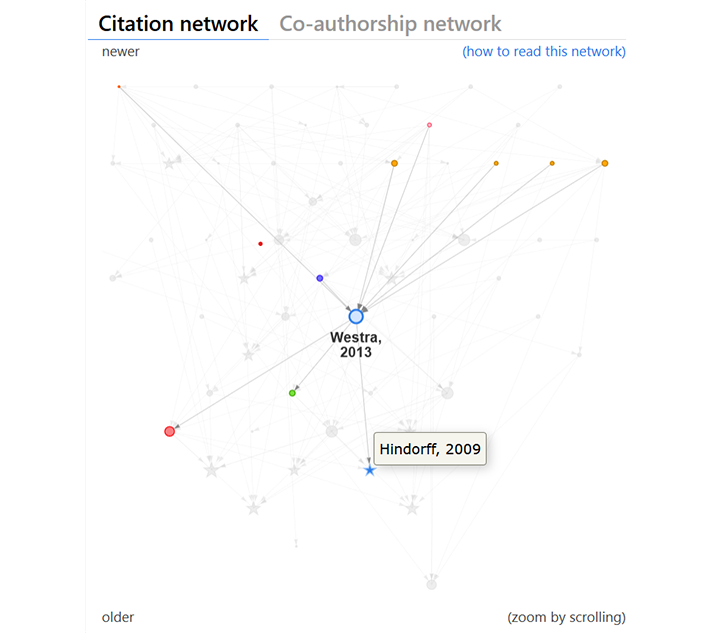
The currently highlighted paper by Westra et al. from 2013 got the most citations from the remaining 57 input articles (7 in total, all of them above – this number is called “in–degree”) and cites two older input papers below. However, you'll notice it cites a third, star–shaped article by Hindorff et al. from 2009: This is a suggested article, a highly cited paper not yet among the set of input articles.
In the overview tables of input and suggested articles you can read the abstracts and sort or filter by title, abstract, author, year and journal. The co–authorship network (not shown) helps to identify the most influential authors among the current articles. You can also open the list of global citations in Microsoft Academic or the complete reference list of a paper in a new tab in Local Citation Network itself, creating a new citation network for them.
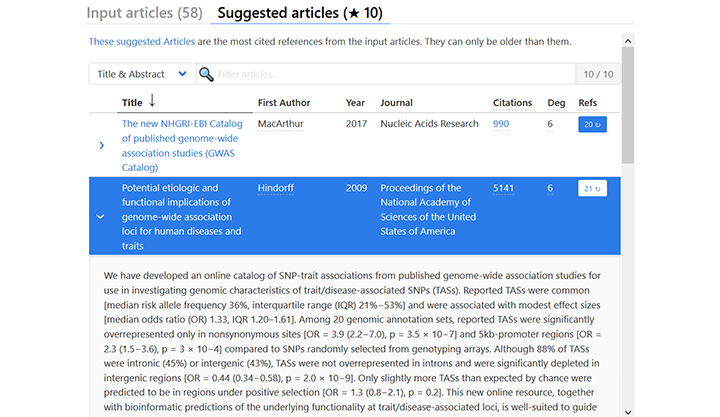
This brings us to the second mode of operation for Local Citation Network: Instead of scanning a text file for DOIs, you can supply a single DOI (which can easily be found in the small print of most scientific publications) and have the web app treat it as a “source article”, constructing the citation network based on all of its references. This way you can get a quick overview of the scientific literature used by a single paper.
Citation Gecko
The second web app I'd like to introduce is similar in spirit but different in implementation: Citation Gecko by Barney Walker. It is older than my Local Citation Network and to be honest, if I had known it, I wouldn't have seen any need to create something myself. Be that as it may, now there are two open source web apps that complement each other very well! I'll briefly walk you through Citation Gecko and then I'll highlight the differences and strengths of each of the two.
Citation Gecko has a more incremental approach: You start with a few “seed papers” (5 or 6 are recommended) and then the web app includes all of their references and even global citations in the citation network, obtained from Crossref and OpenCitations. Including global citations has the advantage that you can also identify papers newer than all of your seed papers, making it bidirectional in time. Next, you can add any recommended paper to your set of seed papers, incrementally increasing the size of your network.
To stick with my example–paper on genetics, I've imported a BibTeX file containing the 6 most important papers from my 58 input articles in Citation Gecko. These seed articles are highlighted in yellow and the node size of the grey recommended articles depends on how many seed articles they cite / are cited by. Again, the article “Systematic identification of trans eQTLs as putative drivers of known disease associations” by Westra et al. from 2013 is highlighted. It only cites one other seed article (the dark yellow node from 2010), the highlighted dark grey articles above it are all recommended because they cite it and the two highlighted dark grey articles below it are recommended because they are cited by it.
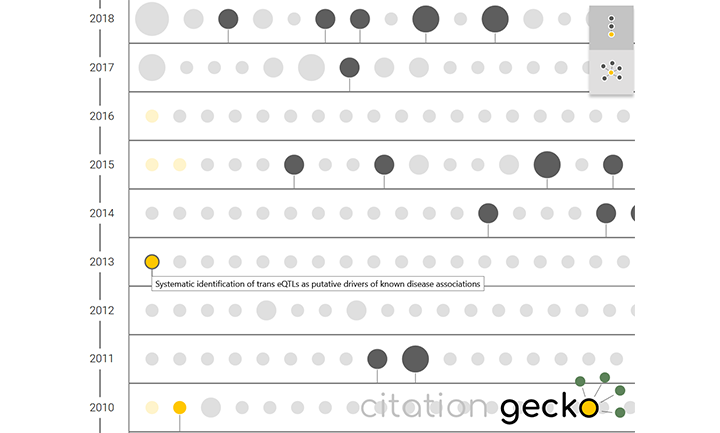
In fact, all articles referenced by the seed papers or referencing them are recommended and you can scroll for a long time in all directions in the timeline view. If this is too tedious, you can also switch to a pure network view (where the gecko has got its name from). Here you have to decide whether you want the edges to represent incoming or outgoing citations. Below is my genetics example and as you can see, the number of global incoming citations can be quite huge with seminal papers (as visible by the big point–clouds around the seed papers). The most interesting recommended papers are now the ones in between, citing more than one of the seed papers. These papers can potentially be added to the pool of seed papers, incrementally increasing the network size.
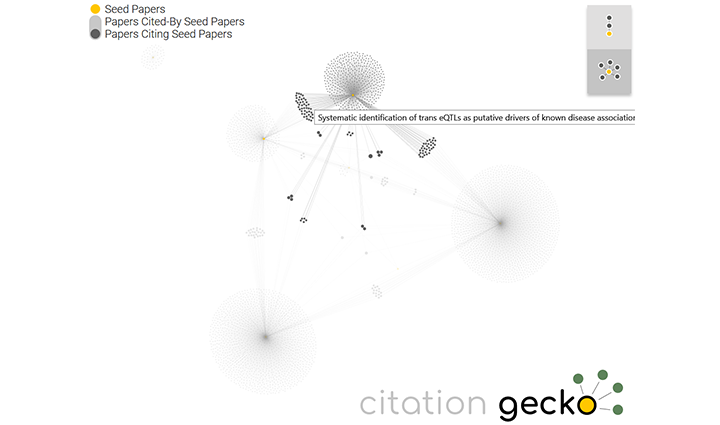
Comparison
Local Citation Network and Citation Gecko each have unique strengths that potentially make them interesting to researchers. Given that Citation Gecko starts with a small number of seed articles and quickly gives hundreds of recommendations, I would recommend using it at the beginning of the literature discovery process. Local Citation Network on the other hand prefers much larger input lists and only gives a few recommendations. I would thus recommend it more at the end of the literature discovery process or to gain a quick overview of the reference list of an already published paper.
- Starts with a small number of seed articles (5-6 are recommended) and incrementally increases network size.
- Crossref and OpenCitations are primary data sources. Global incoming citations are fetched and included in recommended articles, not just outgoing references.
- You can export current sessions and recommended papers as BibTeX files.
- Zotero and Mendeley reference libraries are integrated and can be interacted with.
- Easily handles dozens of input articles (10-200 are recommended), either defined by importing a text file containing DOIs or by obtaining the reference list of a single article.
- Microsoft Academic is the primary data source, which in many disciplines is more comprehensive than Crossref (also supported). Abstracts are available for most articles.
- Co-authorship network allows you to identify influential authors and filter by them in the current set of articles.
- Estimated data completeness is calculated.


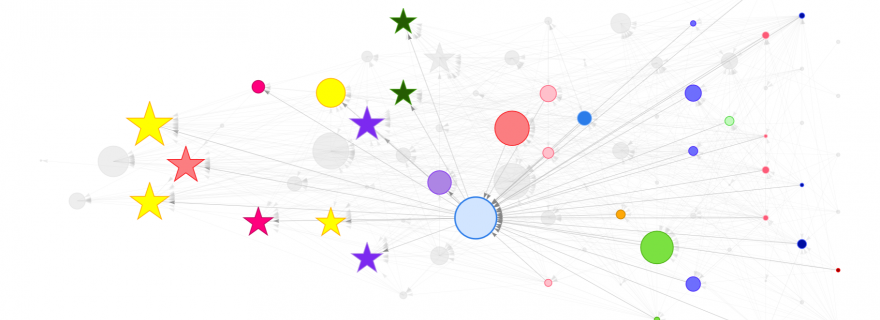
1 Comment
Great article, Tim. And great piece of software! I have long dreamed of something like this!! Is there a reason why you didn't include "global citations" in Local Citation Network?
Add a comment